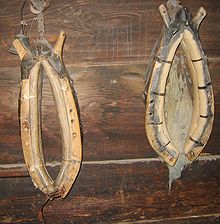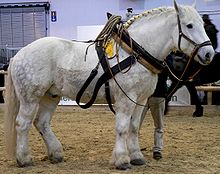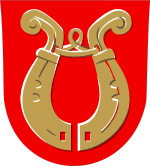
A crossbow is a ranged weapon using an elastic launching device consisting of a bow-like assembly called a prod, mounted horizontally on a main frame called a tiller, which is hand-held in a similar fashion to the stock of a long firearm. Crossbows shoot arrow-like projectiles called bolts or quarrels. A person who shoots crossbow is called a crossbowman or an arbalist.
Tack is equipment or accessories equipped on horses and other equines in the course of their use as domesticated animals. This equipment includes such items as saddles, stirrups, bridles, halters, reins, bits, and harnesses. Equipping a horse is often referred to as tacking up, and involves putting the tack equipment on the horse. A room to store such equipment, usually near or in a stable, is a tack room.

A rudder is a primary control surface used to steer a ship, boat, submarine, hovercraft, aircraft, or other vehicle that moves through a fluid medium. On an aircraft the rudder is used primarily to counter adverse yaw and p-factor and is not the primary control used to turn the airplane. A rudder operates by redirecting the fluid past the hull or fuselage, thus imparting a turning or yawing motion to the craft. In basic form, a rudder is a flat plane or sheet of material attached with hinges to the craft's stern, tail, or after end. Often rudders are shaped so as to minimize hydrodynamic or aerodynamic drag. On simple watercraft, a tiller—essentially, a stick or pole acting as a lever arm—may be attached to the top of the rudder to allow it to be turned by a helmsman. In larger vessels, cables, pushrods, or hydraulics may be used to link rudders to steering wheels. In typical aircraft, the rudder is operated by pedals via mechanical linkages or hydraulics.

A wheelbarrow is a small hand-propelled vehicle, usually with just one wheel, designed to be pushed and guided by a single person using two handles at the rear, or by a sail to push the ancient wheelbarrow by wind. The term "wheelbarrow" is made of two words: "wheel" and "barrow." "Barrow" is a derivation of the Old English "barew" which was a device used for carrying loads.
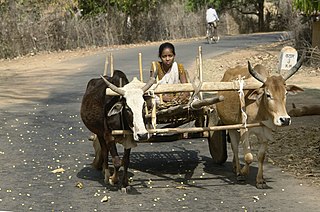
A yoke is a wooden beam sometimes used between a pair of oxen or other animals to enable them to pull together on a load when working in pairs, as oxen usually do; some yokes are fitted to individual animals. There are several types of yoke, used in different cultures, and for different types of oxen. A pair of oxen may be called a yoke of oxen, and yoke is also a verb, as in "to yoke a pair of oxen". Other animals that may be yoked include horses, mules, donkeys, and water buffalo.

A trip hammer, also known as a tilt hammer or helve hammer, is a massive powered hammer. Traditional uses of trip hammers include pounding, decorticating and polishing of grain in agriculture. In mining, trip hammers were used for crushing metal ores into small pieces, although a stamp mill was more usual for this. In finery forges they were used for drawing out blooms made from wrought iron into more workable bar iron. They were also used for fabricating various articles of wrought iron, latten, steel and other metals.

An oxbow is a U-shaped metal pole that fits the underside and the sides of the neck of an ox or bullock. A bow pin holds it in place.

An ox, also known as a bullock, is a bovine, trained and used as a draft animal. Oxen are commonly castrated adult male cattle; castration inhibits testosterone and aggression, which makes the males docile and safer to work with. Cows or bulls may also be used in some areas.
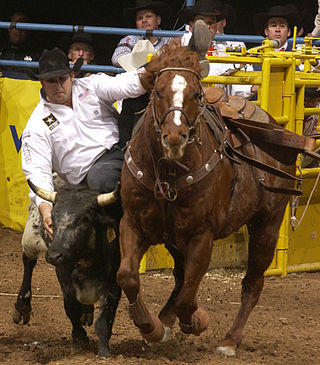
A breastplate is a piece of riding equipment used on horses. Its purpose is to keep the saddle or harness from sliding back.

The first evidence of horses in warfare dates from Eurasia between 4000 and 3000 BC. A Sumerian illustration of warfare from 2500 BC depicts some type of equine pulling wagons. By 1600 BC, improved harness and chariot designs made chariot warfare common throughout the Ancient Near East, and the earliest written training manual for war horses was a guide for training chariot horses written about 1350 BC. As formal cavalry tactics replaced the chariot, so did new training methods, and by 360 BC, the Greek cavalry officer Xenophon had written an extensive treatise on horsemanship. The effectiveness of horses in battle was also revolutionized by improvements in technology, such as the invention of the saddle, the stirrup, and the horse collar.
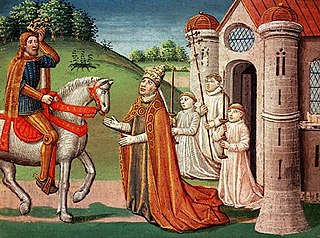
Horses in the Middle Ages differed in size, build and breed from the modern horse, and were, on average, smaller. They were also more central to society than their modern counterparts, being essential for war, agriculture, and transport.

Driving, when applied to horses, ponies, mules, or donkeys, is a broad term for hitching equines to a wagon, carriage, cart, sleigh, or other horse-drawn vehicle by means of a harness and working them in this way. It encompasses a wide range of activities from pleasure driving, to harness racing, to farm work, horse shows, and even international combined driving.
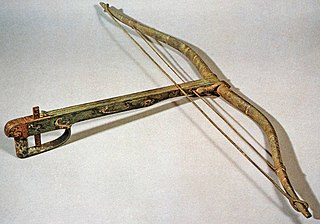
It is not clear where and when the crossbow originated, but it is believed to have appeared in China and Europe around the 7th to 5th centuries BC. In China the crossbow was one of the primary military weapons from the Warring States period until the end of the Han dynasty, when armies composed of up to 30 to 50 percent crossbowmen were not unheard of. The crossbow lost much of its popularity after the fall of the Han dynasty, likely due to the rise of the more resilient heavy cavalry during the Six Dynasties. One Tang dynasty source recommends a bow to crossbow ratio of five to one as well as the utilization of the countermarch to make up for the crossbow's lack of speed. The crossbow countermarch technique was further refined in the Song dynasty, but crossbow usage in the military continued to decline after the Mongol conquest of China. Although the crossbow never regained the prominence it once had under the Han, it was never completely phased out either. Even as late as the 17th century, military theorists were still recommending it for wider military adoption, but production had already shifted in favor of firearms and traditional composite bows.
Horse harness is a device that connects a horse to a vehicle or another type of load.

A swingletree or singletree is a wooden or metal bar used to balance the pull of a draught horse or other draught animal when pulling a vehicle. It is a kind of whippletree, and the term is also used sometimes for other whippletrees.

Breeching ( "britching") is a strap around the haunches of a draft, pack or riding animal. Both under saddle and in harness, breeching engages when an animal slows down or travels downhill and is used to brake or stabilize a load.

A harness saddle is an element of horse harness which supports the weight of shafts or poles attaching a vehicle to a horse. Like other types of saddle, it lies on the horse's back directly behind the withers, often has an internal supportive framework , and usually is secured on either side by a girth passing beneath the horse. Unlike riding saddles, it is an integral part of the harness and is not used as stand-alone equipment.

This is an overview of Chinese siege weapons.
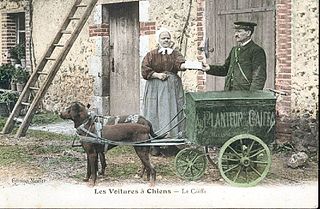
A dog harness is a piece of equipment consisting in part of straps that surround the dog’s torso. It is used to guide, hold, and lift the dog or to utilise its pulling power. It reduces tension on the neck when they pull, and provides free breathing during daily walks. In sports such as mushing and skijoring, where the dog's pulling power is utilized, the harness provides effective use of force while maintaining freedom of movement. These aforementioned kinds of harnesses differ from pet harnesses in that they are specifically designed in order to allow or support a dog in the completion of a working task.
